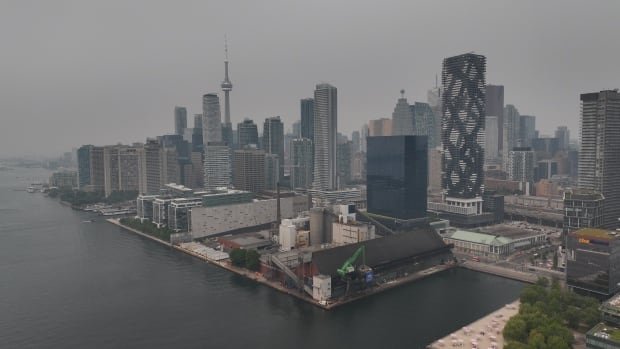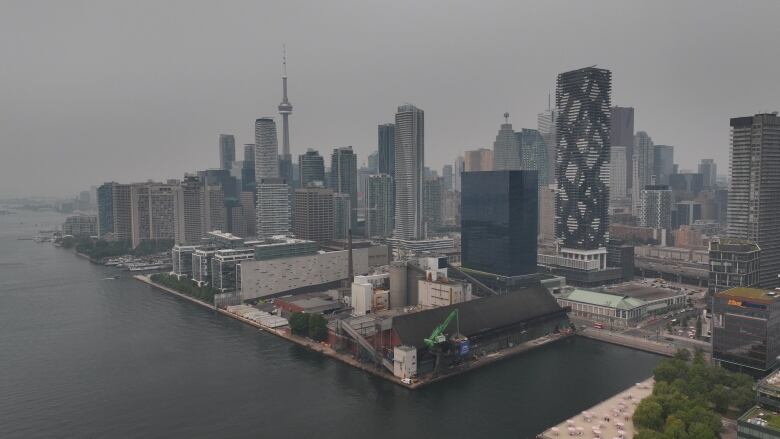Wildfire smoke is in our homes. Here's how to clear out toxic particles
A drone captures a shot of Toronto's smoky skyline from the harbour, as Quebec's out-of-control wildfires bring days of haze. (Patrick Morrell/CBC News)As the smoke from hundreds of out-of-control wildfires dances and lingers above hundreds of North American communities, experts warn about the risks to human health from toxic particles those clouds carry. And because no home is perfectly sealed, air quality indoors can still be affected."On average, whatever the air pollution level outside is — inside is probably about half that," explains Dan Westervelt, associate research professor at Columbia University's Climate School."And so when you're talking about the kind of levels that we've been seeing in the Mid-Atlantic U.S., half of that is still pretty dangerous."So what are some ways this smoke can enter our homes?Check doors, windows, vents Naturally, the largest openings in our homes to the outside tend to be the doors and windows. But even when they're closed, says Amy Li, an air q


As the smoke from hundreds of out-of-control wildfires dances and lingers above hundreds of North American communities, experts warn about the risks to human health from toxic particles those clouds carry.
And because no home is perfectly sealed, air quality indoors can still be affected.
"On average, whatever the air pollution level outside is — inside is probably about half that," explains Dan Westervelt, associate research professor at Columbia University's Climate School.
"And so when you're talking about the kind of levels that we've been seeing in the Mid-Atlantic U.S., half of that is still pretty dangerous."
So what are some ways this smoke can enter our homes?
Check doors, windows, vents
Naturally, the largest openings in our homes to the outside tend to be the doors and windows. But even when they're closed, says Amy Li, an air quality expert at Waterloo University, smoke particles can still "infiltrate into your room through all the cracks and leakages in the building enclosure."

Another source people may not consider is the ventilation system in some buildings. Intentionally designed to bring fresh air into an apartment or condo, Li says the particles could be carried in through these systems.
"It's interesting because typically we need the fresh outdoor air to address indoor pollutants," Li said, recalling the need for fresh air in recent years to reduce transmission of COVID. "But in this case we do not want it if it's not filtered."
Plug the leaks
Closing those doors and windows is the first step during days where the Air Quality Health Index indicates a high health risk, experts say.
Li also suggests if you know of any areas in your home that leak air from the outside or carry a draft, they can be blocked with cloths or towels.
Check your air filters
It's important to keep indoor air circulating, as these wildfire seasons typically coincide with hot summer temperatures. Heat's effect on the human body can take many forms and air conditioning systems can help — with the right filtration and air source.
"You want to make sure that your ventilation system is on, and that you have some good quality air filters on your ventilation system," suggested Roshini Kassie, a specialist at the Water and Air Quality bureau at Health Canada.
Kassie reiterates that systems should be recirculating air, not drawing it from the outside. For apartments, Li suggests examining the air handling unit, which is typically in its own cabinet.
"Check if it has a high efficiency filter," Li described. "If you notice that the existing filter is really dirty, then maybe consider replacing the filter."
Use portable air cleaners
For people who do not have ventilation systems, multiple experts point to a portable air cleaner as a solution. Not all of these devices are created equal, however, so Kassie points to Health Canada's advice covering what to look for.
Some common guidance includes:
- Look for high-efficiency particulate air (HEPA) filters.
- Ensure the device is rated for the size of the room you have.
- Avoid devices that produce ozone, as it can impact your health (it's part of what goes into the calculation of the AQHI).
If you have one of these devices, Li says it's important to run them as often as you can and put them where people are going to be.
"The goal here is really to protect the occupants," Li told CBC News, pointing to an air cleaner placed right behind her chair.

"If you have a large family room where most people are going to gather, maybe after dinner, then place a portable air cleaner there to help improve the air quality."
Visit safe community spaces
Experts stress that these strategies — using portable air cleaners, filtered indoor ventilation and limits on outdoor activities — aren't always accessible. The solution, then, may lie outside the home.

"A lot of people, if they can't control or keep the air clean in their home, they need to go somewhere where there is clean air," Kassie said, using examples of community centres, malls and public libraries. She points to more Health Canada guidance for cities and provinces to create these safe zones in anticipation of and during wildfire events.
"Different municipalities can set up that building or a space like that to invite people to come and take a break from the smoke."
Trust your nose
An important reminder as the smoke and advisory warnings lift for some communities, experts say, is to let fresh air back in.
While checking the Air Quality Health Index can be a good indicator of when to do that, Li says there's still value in following your nose.
"I think what's even more important is to trust your own feeling or smell about the smoke," Li said, because air quality monitoring stations aren't always near your home.
What's Your Reaction?














